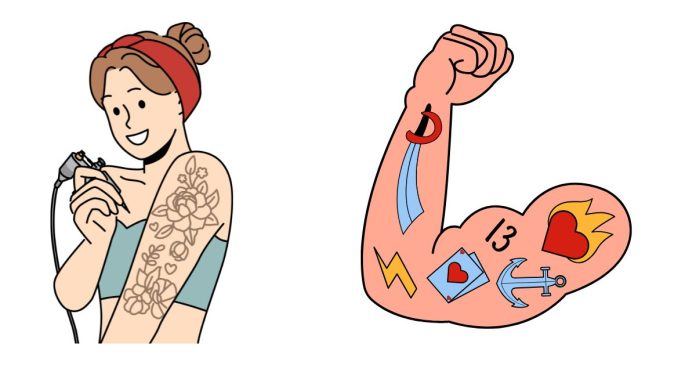The healing time for a tattoo can vary depending on several factors, such as the size of the tattoo, the location on your body, and how well you care for it during the healing process. On average, here’s what you can expect:
1. Initial Healing:
- Timeframe: 1–2 weeks
- The first phase of healing typically takes 7 to 14 days. During this time, the outer layer of your skin (epidermis) begins to heal. You’ll notice the tattoo might peel, flake, or scab over as your skin sheds dead cells. It’s crucial to avoid scratching or picking at scabs to prevent infection or scarring.
- What happens: The tattoo may appear a little shiny, and the area might feel tender. Swelling and redness should subside by the end of this period.
2. Full Healing (Complete Skin Recovery):
- Timeframe: 3–4 weeks
- While the outer layer heals in 1–2 weeks, the deeper layers of skin (dermis) will continue to heal. Your tattoo might still feel a little sensitive or appear slightly raised in the initial few weeks.
- What happens: The skin may look a little dull or faded during this phase, as it’s still recovering beneath the surface.
3. Long-Term Healing (Complete Ink Settlement):
- Timeframe: Up to 6 months
- Although the tattoo may look fully healed on the surface by 3–4 weeks, the full healing process can take up to 6 months. The ink needs time to fully settle into your skin. You may notice the color brightening up after a few months as your skin heals completely.
Tattoo Healing Stages
Here’s a breakdown of what you can expect during the healing process:
- Days 1–3:
- Your tattoo will be fresh and raw, with a layer of protective ointment or bandage over it. You might experience swelling, redness, and some mild pain.
- Days 4–7:
- The tattoo will start to peel and flake as your skin begins to shed dead cells. It’s crucial not to pick at any scabs or flakes, as it can lead to scarring or patchy ink.
- Week 2:
- The tattoo will feel less tender, and the outer layer of skin should begin to heal. You may notice that it looks a little dry or dull as the skin continues its recovery.
- Week 3–4:
- The tattoo should look more settled and feel almost completely healed on the surface. It might still feel a little tight or slightly raised but won’t cause discomfort anymore.
- After 1 Month:
- By this point, the tattoo should be mostly healed on the surface, but the deeper layers of skin may still be recovering.
- 6 Months:
- The full healing process concludes, and the tattoo should now be fully integrated into your skin. The colors may have settled, and the design should appear crisp and clear.
Factors Affecting Healing Time
Several factors can influence how quickly or slowly your tattoo heals:
- Tattoo Size and Placement: Larger tattoos or tattoos on areas with more movement (like joints) may take longer to heal.
- Your Skin Type: People with sensitive skin or conditions like eczema may take longer to heal.
- Aftercare: Proper aftercare is essential for faster healing. Using the right ointments, keeping the tattoo clean, and avoiding sun exposure will help speed up the process.
- Your Health: Overall health, hydration, and nutrition can impact how quickly your body heals.
Aftercare Tips for Faster Healing:
- Keep It Clean: Gently wash the tattoo with mild, unscented soap and lukewarm water.
- Moisturize: Use a fragrance-free, tattoo-friendly lotion or ointment to keep the skin hydrated.
- Avoid Sun Exposure: Keep your tattoo out of direct sunlight and avoid tanning beds during the healing period.
- Don’t Scratch or Pick: Let scabs and flakes naturally fall off to prevent scarring.
- Wear Loose Clothing: Avoid tight clothing that can rub against the tattooed area and cause irritation.
- Avoid Submerging in Water: Skip swimming, hot tubs, or soaking in baths for at least 2–3 weeks.
Final Thoughts
- Healing Time: Most tattoos will heal within 3 to 4 weeks, but full recovery can take up to 6 months.
- Aftercare: Proper care during the healing process is crucial to prevent infections and ensure vibrant, long-lasting results.
Listen to your body, and if you notice anything unusual (like excessive redness, swelling, or pus), consult with a professional to rule out any infections.


